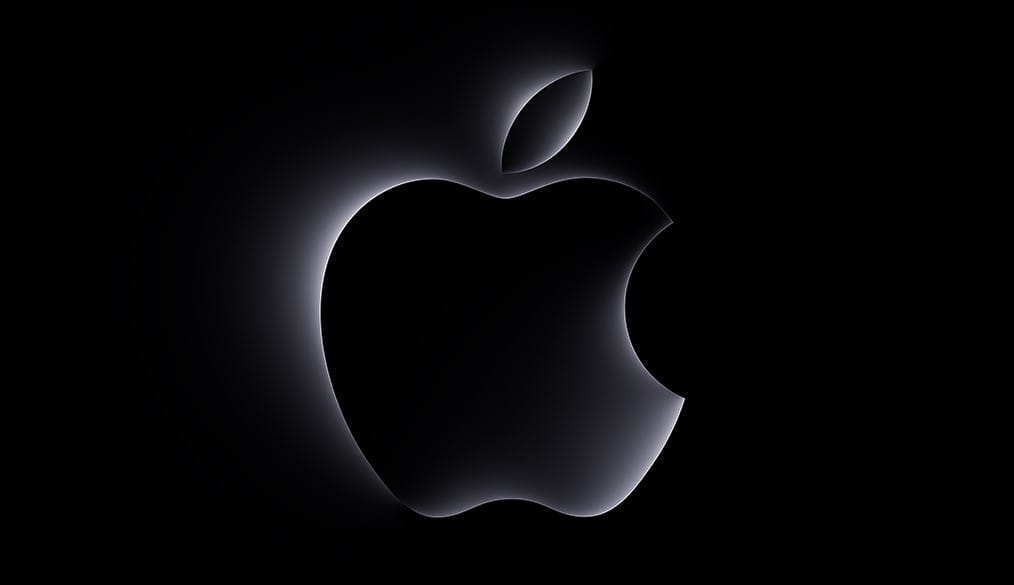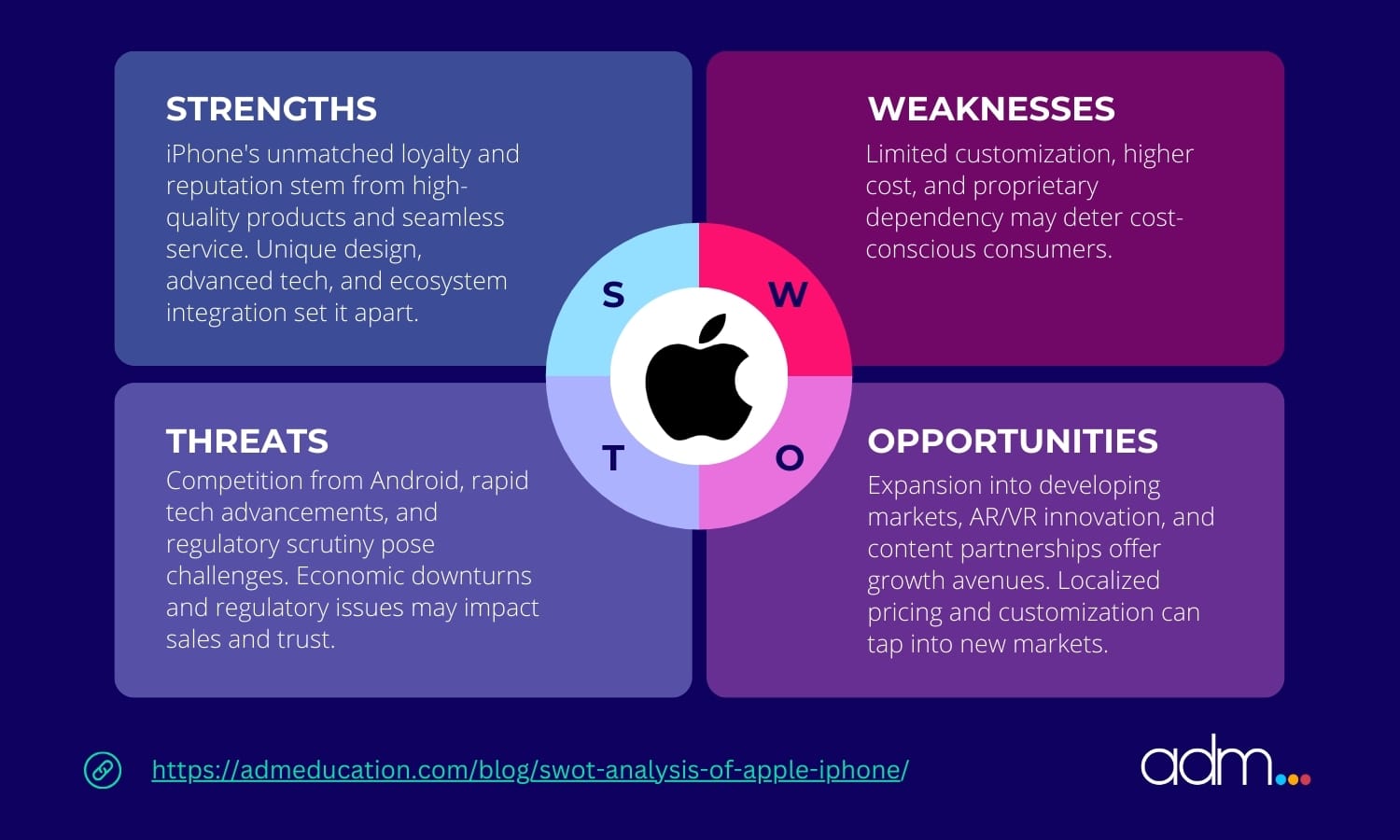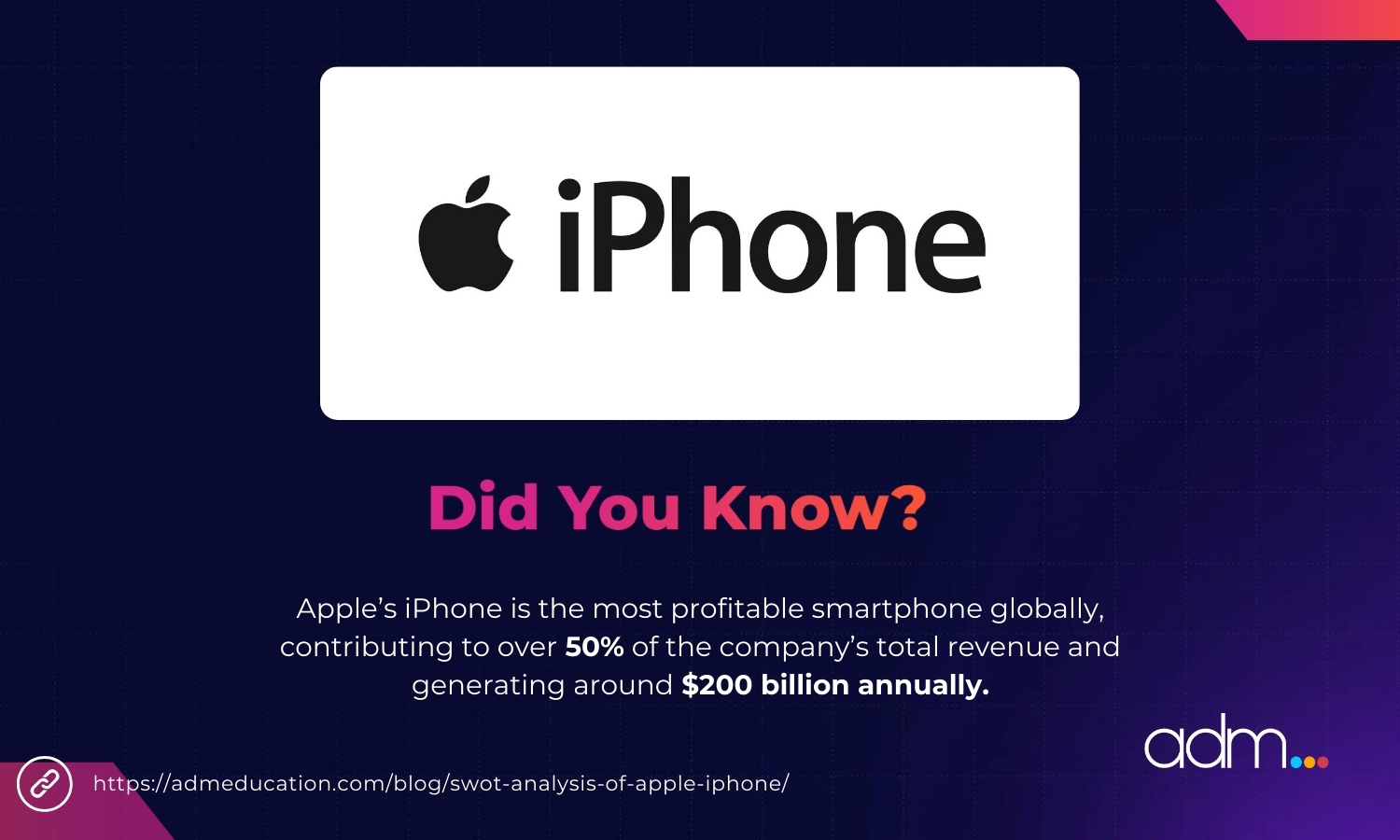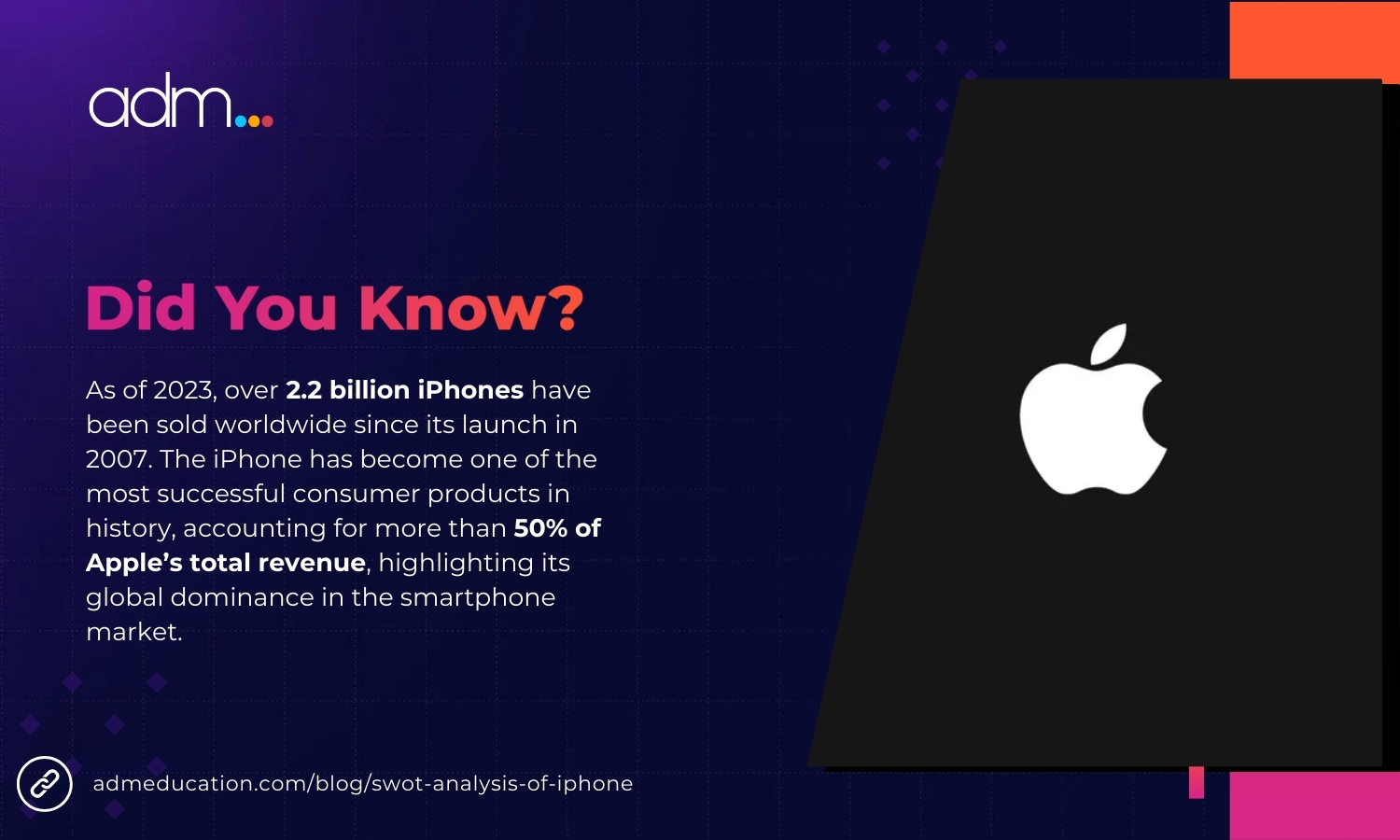The iPhone is a flagship product of Apple Inc. and has been transforming the smartphone industry since its inception. This detailed SWOT analysis of Apple iPhone focuses on the prominent features of the iPhone brand and analyzes its strengths, weaknesses, opportunities, and threats.
About iPhone

Apple iPhone is a renowned brand of smartphones known for its impeccable technology, sleek design, and smooth integration with the Apple ecosystem. Since 2007, the iPhone has set its standards high for better user experience and innovation.
With its features like powerful cameras, face ID, and truly advanced security measures the company is a dominant player in the global smartphone market having an unbeatable combination of relentless repetition Innovation, and a loyal customer base.
Buyer’s Persona
iPhone users are typically tech-savvy persons who value smooth integration, reliability Innovation, and security. These groups of people prioritize functionality and style in their devices and often look for the latest updates in technology. iPhone users are quite active in their digital lives and mostly depend on their smartphones for communication, entertainment work, and staying connected with their family and friends.
These buyers appreciate the iPhone’s interactive user interface, strong security features, and high-quality camera capacities. Considering its high price, iPhone users are still willing to invest in their premium products to enjoy their high productivity and standard lifestyle.
Pain Points
Common pain points for any iPhone user include –
- Software Glitches
- Lack of Personalization
- Battery Life Concerns
- Issues With Data Security and Privacy
However, solving these challenges with regular software updates, customized features, and better security measures can highly improve the overall user experience of the iPhone and also boost customer loyalty.
Additionally, by actively listening to customer feedback as well as addressing their pain points immediately the company can ensure that iPhone users can still enjoy a seamless and satisfying experience.
Social Media Presence
The iPhone maintains a strong presence throughout its various social media platforms including YouTube Instagram Twitter and Facebook. With engaging content tutorials product announcements and user-generated content Apple makes use of social media to strengthen its customer engagement brand perception and also builds a vibrant community of loyal customers.
Social media platforms prove as valuable channels for customer feedback allowing the company to address issues collect insights and maintain constant communication with its audience.
SWOT Analysis of Apple iPhone
Now we will explore the detailed SWOT analysis of the Apple iPhone step-by-step.
Strengths of iPhone
-
Customer loyalty and strong brand reputation
iPhone has an unmatchable brand reputation and seamless customer loyalty in the smartphone market. Its unstoppable delivery of high-quality products along with its exceptional customer service has made its position strong as one of the trusted and most preferred brands across the globe.
This converts into repetitive purchases and creates a dedicated and honest customer base that enthusiastically projects new updates and releases.
-
Unique design and technology
Apple consistently surpasses the boundaries of not just design but also technology with every release. Right from world-class features like Face ID and the inception of the new concept of Retina Display to advancements in camera technology and more, the iPhone is setting its standards high in the industry.
It drives innovation within the industry alongside other competitive companies. The cherry on the cake is the minimal and sleek design that sets it apart from all its competitors.
-
Smooth ecosystem integration
The keystone of the iPhone is its smooth integration with the other Apple products. Advanced features like Airdrop, iCloud, Continuity, and Handoff help smooth connectivity as well as synchronization between iPads, Macs, iPhones, and other Apple devices.
The integration helps the user experience get better while also promoting device connectivity and fosters users to invest more in different Apple products. This empowers loyalty as well as dependency on the ecosystem system.
-
Strong security features and privacy factors
Privacy and security are the four biggest concerns for smartphone users. Apple’s sheer commitment to all these principles is a significant power of the iPhone. The iOS operating system is popular for its strong security architecture, regular updates, and much more such features that help protect user’s data against any cyber threats.
Special features like face ID, Touch ID, app tracking transparency, and end-to-end encryption instill confidence in the iPhone’s security traits.
Weaknesses of iPhone
-
Limited customization options
Unlike some of its Android counterparts, the iPhone delivers limited customization options for its customers when it comes to user interface and software personalization. Simple user experience throughout all its devices this approach may be continued as restrictive by some individuals who prefer more customization features like themes, wizards, etc.
This lack of agility deters potential customers for whom personalization stands at the top of their smartphone experience.
-
Higher cost compared to competitors
The most notable weakness includes the consistently increasing price of the iPhone when compared to other smartphones in the market. Apple has been positioning its devices as the most premium products with state-of-the-art technology in design. The increasing price tags definitely prohibit a lot of customers, specifically those with low purchasing power.
The pricing strategy may bring less likeliness to buy Apple products in the market and limit its potential buyers, especially in those regions where affordability is the major factor to consider.
-
Lack of affordability for a few market sections
Respective of offering installment plans as well as trade in programs to deal with the upfront cost, the iPhone is still seen as the unaffordable element for certain market segments. These market segments particularly include price-sensitive and budget-conscious consumers.
This strategy of exclusivity results in missed opportunities for Apple to enter into the low-income population or to capture a significant market share in those regions where people cannot even think of buying a phone of a higher price. On top of that, competitors that are offering feature smartphones at low prices are also one of the significant challenges to iPhone sales.
-
Proprietary hardware and software dependency
This weakness can restrict interoperability as well as compatibility with non-Apple services or devices. Apple’s closed ecosystem ensures smooth integration and better security within its product lines but it also limits users’ actions to easily switch between different performs or access a variety of third-party accessories or applications.
This level of dependency on Apple’s ecosystem hinders users from buying their products and preferably gets open to buying other brands of mobile phones where they can get greater freedom of choice in hardware and software selection.
Opportunities for the iPhone
-
Expanding its presence into Markets
With increasing incomes and smartphone penetration in developing countries like Indonesia, Brazil, and India, there is a vast unseen market for premium smartphones like the iPhone.
With a strategic method that can include various pricing plans, installment payment plans, and customizing products to local needs, Apple can definitely capitalize on the growing demand for high and secure smartphones and can drive sales growth to a new level.
-
AR and VR Innovation
Today, Virtual Reality and Augmented Reality show the most promising areas for consistent innovation and distinctiveness in the market. ARkit of Apple and its investments in glasses display its true commitment to leading the revolution.
With Apple’s one-of-its-kind features of the iPhone’s powerful software and hardware, Apple can climb new heights in its AR and VR space. These are ought to transform how users interact with their devices as well as the things around them.
-
Co-creation with content makers
Communicating with content creators and developers presents a handful of opportunities for Apple company to enhance its ecosystem with attractive applications, services, and content. By creating partnerships with media companies, educational institutions, other content creators, and game developers the company can surely enhance the value proposition of its devices and can appeal to potential users.
Moreover, this strategy can also facilitate exclusive content development promotional campaigns as well as experience that brings high engagement and positions the company differently from its competitors.
Threats to the iPhone
-
Strong competition from Android-based smartphones
The iPhone conference has intense competition from a variety of Android-based smartphones including Samsung, Xiaomi, Huawei, and OnePlus. These competitors deliver a wide range of devices at different prices while serving various customer budgets and choices.
The open-source nature of Android smartphones empowers diversity and innovation that poses a constant challenge to Apple’s brand dominance and market share.
-
Fast tech advancements by rivals
At present, the smartphone market is specialized by faster technology advancements with its arrivals continuously coming up with innovations advancements, and features in hardware and software.
Competitors may also leverage the latest technology like 5G connectivity, foldable screens, and advanced camera functions to position their products as different and help appeal to customers. However, failing to stay abreast with these advancements, the iPhone may result in losing its competitive edge as well as market reliability to a greater extent.
-
Regulatory challenges
Increasing scrutiny from lawmakers and regulators regarding antitrust issues, data privacy methods, and market dominance is a vital threat to Apple as well as its business model.
Stringent regulations, legal battles, and fines related to violating data privacy monopolistic practices and anti-competitive behavior eradicate customer trust and can also damage the brand’s reputation. It may result in financial penalties or any operational restriction for the company.
-
Economic downturns
Economic recessions, downturns, or any global crisis definitely impact customer spending habits, especially on luxury products like smartphones. In tough periods of economic uncertainty, customers may prioritize required purchases over optional items like premium smartphones.
Various factors like economic fluctuations, currency devaluation, or any changes in customer sentiment could see the company declining sales, less revenue, and increased pressure on Apple’s financial profitability as well as performance.
Also read, SWOT Analysis of Amul.
Top 5 competitors of the iPhone
Here are the top competitors of the iPhone –
- Huawei: Respective of facing challenges, Huawei remains a leading competitor on a global level with its P and Mate series smartphones popular for their sleek designs and innovative features.
- OnePlus: OnePlus has established itself as distinctive by offering its premium features as well as performance at comparatively affordable prices and most profoundly targeting tech-savvy customers with its flagship unique smartphones.
- Xiaomi: Xiaomi is another strong competitor to the iPhone offering super-quality smartphones at awe-struck prices with its Redmi and MI series smartphones.
- Samsung: Samsung has direct competition with the iPhone with its various range of Android-based devices offering top-level technology as well as design in flagship series like Galaxy Note and Galaxy S.
- Google Pixel: Google Pixel smartphones are very popular for their pure Android experience as well as outstanding camera performance. It competes with the iPhone in terms of software innovation and integration with the company’s ecosystem.
Conclusion
The SWOT analysis of Apple iPhone showed that the iPhone stands as an unprecedented strength in the market due to its strong technology back-up, brand recognition, and cohesive system integration. Amid facing challenges, the company truly holds promising opportunities for an innovative future.
Mitigating complexities requires adaptability and accurate strategy. Still, with its track record of customer satisfaction and innovation, the iPhone has strong potential to shape the future of mobile phones, positioning it as a global market leader in the industry space.
Janardan Das is a seasoned Growth Lead with over five years of experience in digital marketing. He specializes in crafting effective marketing strategies, including SWOT analysis and digital marketing courses, to help businesses thrive in the competitive landscape. He is passionate about sharing his knowledge and insights, empowering others to succeed in their marketing endeavors.




